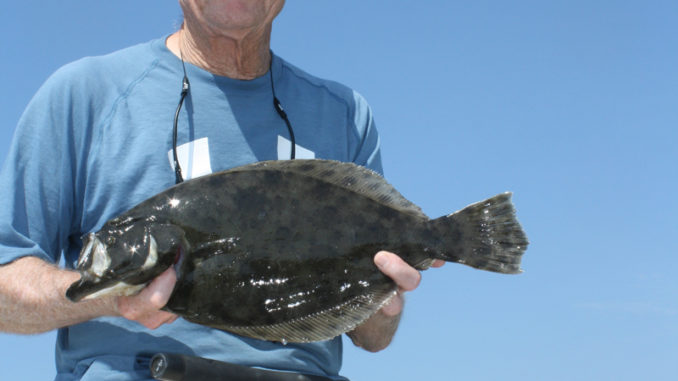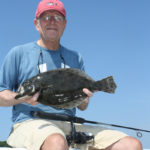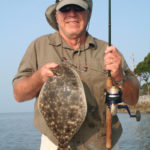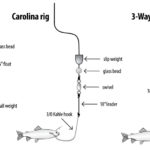
Lowcountry anglers can target tasty, often-overlooked flounder instead of just catching them by accident.
Warm breezes, sunny skies, reasonable temperatures; everybody loves floating the creeks, inlets and bays around Beaufort and Hilton Head in June.
Cobia, speckled trout and spot-tail bass — aka redfish — are all actively feeding right now, but for those people who love the taste of flaky, white fillets, there is hardly a better piscatorial target than the feisty southern or summer flounder.
If your goal is putting lots of fillets in the freezer or providing for a neighborhood or family fish fry, then gigging is the most-effective technique, but not everyone wants to roam creeks in the middle of the night when normal people are home sleeping.
Recreational anglers catch flounder, but often they are caught incidentally or accidentally while casting to areas where redfish and trout are likely to be holding — because flounder like the same places. For those hungering for flounder fillets and not interesting in gigging, flounder can be targeted specifically.
Guide Mark Nutting of Bluffton’s LoCo Fly Charters works local waters with light tackle of all kinds for every species, and he has plenty of tricks when targeting flounder. He’s led enough anglers to flounder after they’ve caught redfish and speckled trout and want a “Lowcountry Slam” to have noticed some definite patterns.
“They tend to more closely associate with trout waters than redfish waters, as redfish tend to stay shallower and trout like slightly deeper water with more flow,” said Nutting, who said flounder won’t often visit the marsh grass that redfish love.
Southern and summer flounder are very aggressive, ambush predators that may appear docile as they lay camouflaged and motionless on the bottom, waiting for prey to swim past. They are anything but docile when attacking prey and, when jabbed by the sharp steel of a hook, will fight furiously. As opportunity feeders, they will eat almost anything that swims or floats past, but the larger ones prefer eating small fish.
Nutting looks for flounder where water flows across something such as an oyster rake, sand bar or a small change in depth. He pointed out subtle color differences in one area of a mud/sand bottom that indicate slight differences in depth. The hydraulics of water flow create a slight eddy effect when water flows across a depression. Flounder tend to be on the back side or downcurrent side of a depression; they like a current flowing over them but will avoid strong flows.
Look for current lines, color lines, eddy lines, tide lines, scum lines, shell lines, shore lines or weed lines. If you have a choice, cast to a line, a rule of thumb that applies to almost all fishing.
Other places flounder hang out are the downcurrent side of creek mouths, even very small ones, and points. They can be found on all sorts of bottom structure, including shell, rocks and riprap, but mud and sand bottom is easiest to fish because there are fewer hang-ups when retrieving lures and flies slowly.
“Actually, the easiest way to find good flounder water is to go gigging without spearing the fish,” Nutting said.
Once in a promising area, he looks for fish while his clients blind-cast to likely spots. Flounder show themselves in subtle and sometimes not-so-subtle ways. Ask yourself questions when fishing. What made that bait jump or those birds dive? Was that a mullet or flounder that jumped? Mullet jump all the time in the summer for seemingly no reason, but flounder also sometimes jump fully out of the water when striking at prey. It’s sight-fishing, so to speak.
Working the water with lures or flies when targeting flounder calls for a little slower and more-thorough presentation than when blind-casting for trout or redfish. Drag likely areas repeatedly with your lures or baits because flounder are ambush predators that attack bait swimming close by them and tend not to chase too far. Blind-casting under docks or near riprap walls can also produce strikes.
Any tackle used for redfish and trout is just fine for flounder. When rigging specifically for flounder, Nutting lightens up a bit to a medium-light, 7-foot spinning rod and a 2500 series spinning reel with 20-pound braided and a 3-foot leader of 20-pound monofilament. He ties an interesting knot connecting the braid to the leader, an FG knot, that is similar to the last step of a Bimini twist, but any connector such as a loop-to-loop will work fine.
He opts for a 1/8-ounce white or red jighead rather than the traditional ¼-ounce version used for trout and spot-tail bass to get the slower sink rate that comes with slower retrieves. Nutting said any soft-plastic trailer suitable for redfish will work fine, scented baits not being needed because flounder strike movement and do not follow scent.
Nutting uses an 8-weight fly rod with floating line when targeting flounder, but anglers could drop down to a 6-weight with a sinking, shooting-head line to keep the fly close to the bottom. With a floating line, fly casters should use a weighted fly to probe close to the bottom, while spin casters generally use a slower retrieve that also keeps the lure near to the bottom. Flounder will chase bait swimming above them, and Nutting has even caught them with a fly-rod popper on the surface.
Danny Rourk of Beaufort’s Tailwind Charters said anglers fishing for flounder with bait need to mimic the things they do fishing for redfish.
“When clients ask me how to catch flounder, I tell them to keep doing exactly what we are doing when looking for redfish and trout,” he said, admitting, that he changes things slightly when using bait.
On smooth bottoms where hanging up is not a problem, he fishes a Carolina rig with a mud minnow or finger mullet on 18 to 24 inches of leader in front of a swivel. He threads a half-ounce egg sinker and glass bead on the running line above the swivel. He suggests anchoring in a good spot and casting around the clock, working the area thoroughly. Sometimes, he adds a small spinner blade above the hook as an attractor for extra flash.
Fishermen catch flounder from the beach, too, often casting and retrieving a Carolina rig or a three-way swivel, where a light bell sinker is tied on a 6-inch leader to one eye, a Kahle bait hook tied with 18 inches of leader to the second eye, and the running line to the third. A cast and slow retrieve with either rig allows the baitfish to swim back and forth in the water disturbed by the bottom-bumping sinker.
When working over shells or where hang-ups are likely, Rourk uses cork rigs adjusted so the bait rides 2 inches above the bottom. Again, his bait of choice is a lively mud minnow or finger mullet.
Rourk points out that a key to fishing bait along the bottom is knowing what the bottom characteristics are and picking the correct rig for the spot.
“If a client gets hung up on his first cast, they will abandon the technique immediately,” Rourk said.
DESTINATION INFORMATION
HOW TO GET THERE — I-95 and US 21 will get you to Beaufort in the least amount of time. To access the Hilton Head end of the Lowcountry, take I-95 to US 278 to the Island. Alljoy Landing is the best access to the May River, and landings at the base of the SC 170 bridges over the Chechessee and Broad Rivers are popular. Sam’s Point Landing on Lady’s Island and the Station Creek Landing on St. Helena Island will give you good access to waters to the east of Beaufort.
WHEN TO GO — Flounder arrive inshore around Beaufort in May, but the best fishing really starts in June. Fishing is typically better in the last couple of hours before low tide, but they can be caught on any tide. Gigging is generally done at night on the low end of the tide cycle.
FISHING INFO/GUIDES — Danny Rourk, Tailwind Charters, 843-263-3863, www.tailwindcharters.com; Mark Nutting, LoCo Fly Charters, 843-540-7302, www.loclflycharters.com; Jack Brown, Predator Fishing, 843-838-9369; Owen Plair, 843-821-3656; Richard Sykes, 843-838-2245; Tuck Scott, 843-271-5406; Dan Utley, Fishing Coach Charters, 843-368-2126; Bay Street Outfitters, Beaufort, 843-524-5250; Boat and Dock Supply, Port Royal, 843-986-0552; Grayco Hardware, Lady’s Island, 843-521-8060. See also Guides and Charters in Classifieds.
ACCOMMODATIONS — Beaufort Area Chamber of Commerce, 843-986-5400, www.beaufortchamber.org.
MAPS — Top Spot Waterproof map number N233, showing details on many of the local shallow water spots, is available from local tackle shops.







Be the first to comment